
Cadillac Ranch
American Sabbatical 60: 12/6/96
Cadillac Ranch
12/6-8.. The Highway.

Cadillac Ranch
The pace picks up now, and the miles stretch out. Your focus narrows when you are flying
along at 75, and the panorama blurs.
We had been lucky with the weather in Arizona. A big Rocky Mountain
storm rose up the sky to the northward and leaned over the mountain
wall at Flagstaff, but only a spit or two spotted the Owl’s face.
Now we were finally turning eastward in opening sunshine, with
no retrogressions, we swore. And we ran out of the pine-clad massifs
and back onto the dry flats of the Colorado Plateau. Ruddy buttes
and mountain walls ran northeast diverging from our path, their
tops white with snow, and we could imagine travelers longing for
them out in these arid wastes. We longed, too. Up there lay the
canyonlands and painted marvels of the southwest. Places I’ve
only seen the leading-edge of in eastern Utah (Arches), and ache
to paint and gawk at. Bryce Canyon, after all. But not this time.
We have not looked down into the great gorges on this circumnavigation.
The Snake River Gorge (America’s deepest), the Columbia Gorge,
the Green River, Grand Canyon. Maybe we’ll have to do "Gorgeous
America" another time. We did look down into a personal abyss,
though, and that’s enough vertigo for one journey. We made promises
to each other we’d come back to the high West, and its deeps,
and circle our wagon here.
Desert ecologies succeed one another across northern Arizona and
New Mexico. Cacti yielding to sage to juniper and back. There
IS some sort of clean demarcation between the two states. The
rock colors change as you wiggle through a series of buttes, and
that Arizona burnt sienna goes dusty beige. I don’t know the history
of how two states came out of the old New Mexico, and am surprised
again, at how often political boundaries do follow ecologic patterns,
despite the bioregionalists’ plaint. Traveling at this speed,
perspective shifts, and the mind’s eye looks down on large-scale
maps. What if watersheds had different colors, and altitudes were
indicated by different saturations? Then the drainages might be
clearer. Degrees of aridity might be portrayed by a gray-scale
spectrum. O the Owl is flying now.
We are crossing Navajo lands, and modern hogans are frequent in
the family compounds. The plateau we are crossing has sufficient
grassland for sheep, or did until overgrazed, and there are still
woolies and horses here and there, along with pickups and beaters.
Houses and outbuildings are often snugged up to the foot of a
looming butte or escarpment, and those on the north sides look
chilly in the noontime shadows. We pass a circled crowd of people,
way out in a desert place, and wonder if it is a cure ceremony
in progress. We wish our culture has communal rituals for bringing
individuals back into balance.
Mount Taylor, in northern New Mexico wears a cloud cap, but the
brightness prevails on our pavement. Singular events stick in
your mind as the scenery flashes by. Four men are standing at
the corners of a van in the median strip, as we approach. They
reach down, pick it up, and walk toward the opposite lane. It
must be a styrofoam mock-up, but we are past before that registers.
And we howl. We’ve punched in another book-on-tape, RUNAWAY JURY,
and our eyes and ears are competing for attention again. We will
hear the verdict before Arkansas.
Still in New Mexico, the long road rolls over a rise as the shadows
lengthen, and we see the clouded tops of the Sangre de Christo
mountains lofting across the eastern sky. Below, and to our right,
there is a widening ribbon of blue on a flat bottomland, the Rio
Grande. Then it’s up another long slope, over, and there is Albuquerque
spread out along the river basin beneath us. The ruddy lower slopes
of the pleated mountains could, indeed, be bloody in the sunset.
Peggy has plotted another meet here, and we find our way to a
Thai restaurant by the university, for dinner with her long-ago
graduate advisor, Louise, and her family. Albuquerque had been
recommended to us as a real southwest city of considerable charm,
but all we saw were the stripmalls and restaurants of the outer
urb, and were insulted again by the rude traffic. (Too many miles
on backroads where common courtesies are, well, common, have spoiled
us for overautomated America.) The dinner was delicious and spicy,
as was the conversation. Academic intellectuals can be as lively
as chicken with ginger, when they get warmed up. Unfortunately
the hot stuff gave us both a hard night, which was always my reaction
to academics. Peggy felt bad enough in the AM for us to consider
seeing a doctor. She’s had a chronic gastric complaint for two
weeks now, but when we called our doctor’s office in Maine, we
discovered it was Saturday! So we couldn’t get sick, and we went
back to Rt.40.
This is the same autobahn we saw as a ribbon of lights across
the Mojave, and there is no doubt you are on a major artery. Convoys
of juggernauts roll by non-stop. As the bumperstickers say, "Without
Trucks, America Stops." Parallel to the pavement, rail-lines are
carrying freight, and there is generally a long piggyback train
in sight. It’s still strange to see trains without cabooses, since
the changed crewing laws did away with brakemen. The trains are
somehow incomplete. (All the cabooses, as we know, are at episcopal
campgrounds, having conferences). The longhaul truckers are generally
orderly drivers, with only the occasional loony doing 85. But
auto drivers on these endless stretches have shut their little
peabrains down, and are heedless of the hazards around them. We
are just touching the ground at 75, and they blow by us, fishtailing
full-throttle. The super highway truly is a metaphor for individualism
run wild.
Wild or tame, we up and over the saddle of the Sangre de Christos.
Our route essentially skirts the southern edge of the Rockies,
and we only see a few mountain tops peeping over our horizons.
We watch the grasses thicken and the shrubs fill out. Cotton and
turf farms appear, ostrich farms gallop by. When we saw rolled
turfs in the desert outside Bakersfield, we were amused that the
lawns of America were being plotted in a great wasteland. Now
we saw that these irrigated plantations are fertilized with grazing
sheep. Magnificent: mow and manure and raise mutton simultaneously.
Did that come out of an Ag. school? Not the manure, I mean.
The land gets even flatter in Texas. We saw this in the high prairie
of the Dakotas, but it still astonishes. This is still cowboy
country, or at least cattlerange, because we are seeing more and
more beef on the hoof, and the bunch grasses look lusher. When
signs for Palo Dura Canyon flash past, I long to pull off and
wander through the Wild West of the 1870’s and 80’s, but it’s
December 96, and we are promised. Long tableland escarpments and
stony canyons intersect the grassy plateau we are dusting across,
and we try to catch a glimpse of rustlers and Lone Rangers.
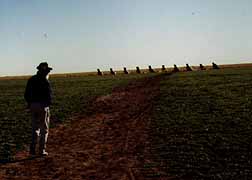
Pilgrim
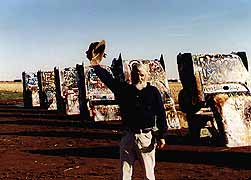
American Ornaments
Across the 100th meridian again, the amount of available moisture
is noticeably greater. Cottonwoods in the streambeds. More leafy
veg. One cholla, at least, thrives in this wetter domain, and
for hundreds of miles the biggest "shrubs" are bristly bushes
of this cactus. No wonder the cowboys wore chaps. And there are
now bronze grasses standing above the beige.
Coming into Amarillo with eager anticipation, we are craning our
necks to find Cadillac Ranch, and there it is. An hundred yards
off Rt.40, running parallel with the national ethos, 10 finny
Cadillacs are buried windshield deep in the Texas clay. All in
a row, their backsides airing-up at 60 degree angles, they are
the Car Henge out of ornamenteurs’ lore. We stomp out to them
across the brown ooze, and admire the graffiti that now adorns
them. This is truly an inspiring country. After our pilgrimage,
we wipe our boots. We also stop in the big Borders Bookstore hardby
the interstate, to get a pot boiler for Peggy, and the place is
jammed with Sunday shoppers. Is this really Texas?
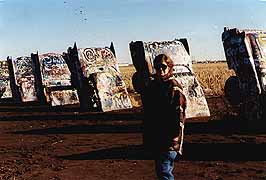
Heart of the Heartland
Yup, all day. And Oklahoma, too. We limp into a Super8 in Elk
City a couple hours after dark, and are politely treated with
great charm by the Pakistani owners. All fall down. And get up
and go again. Oklahoma is another surprise. Not the empty rolling
prairie we’d expected, but more like Iowa, especially in the Canadian
River valleys. And it’s full of hardwoods! Full-bodied oaks with
their leathery leaves still clinging, and hosts of other bare-limbed
deciduous delights. At first in the gullies and river bottoms,
then mixed with large cedars, then covering the entire landscape.
This Indian country is very beautiful, even in a winter season,
and we realize that there must have been some smiles at the end
of the Trail of Tears.
We swing off for gas and a stop at a Cherokee Nation Store in
eastern OK, and I have to promise Peggy we will come back to Sequoiah’s
House, and Muskogee, on the next lap of our journey. Our trail
ended in tears on the west coast this time. Next time we’ll start
in Georgia and follow the Indian relocation trail to Oklahoma.
Seeing how lovely this place is will make it more enticing.
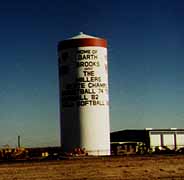
Home of Garth Brooks
And then Arkansas: Rt.40 follows the Arkansas River to Little
Rock, and threads along north of the Boston Mountains. This state
is one of those little-known gems in our national jewelbox. It
reeks of New England to these homesick travelers.. with patches
of Connecticut and Massachusetts. The Arkansas is dammed up into
a multitude of lakes, and all that water is balm to our dusty
eyes. Then there are sections of Mid-west and even high prairie
again. It’s easy to see how Bill Clinton can be everyman. In the
restaurants the dialect is pure Southern, the dress Western, and
the colors motley. On this Sunday afternoon we are noticeably
under-dressed, with the black parishioners particularly elegant.
And it’s God’s country, too. The radio is 50% preachin and 50%
country, and we sample both for a regional taste. God and the
Razorbacks, we might add. Towns have big signs bragging up their
teams, between the megabillboards announcing that Jesus Saves.
“Home of Garth Brooks.”
Heads spinning, we limp across northeastern Arkansas in the dark,
following obscure directions to Piggot, on the Missouri line,
close to the Mississip. I crossed this bit once when I visited
the Torberts on their goat farm in the Ozarks, and remembered
rice paddies and catfish farms glittering alongside the road,
but at night there was only a humid blackness with lines of lights
in the far distance. We did see agricultural machinery working
across the scene with spotlights shining, but couldn’t tell if
the ground was wet or dry. We are in another corridor, here: the
north-south railway channel, and train after train blew past us,
blinding us with their headlamps. We were tired puppies when we
finally found our way to the rural refuge of Carolyn and Richard.
She was a colleague of Peggy’s in Freeport, and one of our E-mail
correspondents, now transplanted to Piggot because Richard’s company
builds prefab structures here. These ex-Mainers are constructing
an owner-built home in idyllic rolling pasturage here, and welcomed
us into their partially-finished mansion with gracious southern
hospitality.
We could barely make sensible remarks. Maybe they weren’t. The
bed was very soft. Now it’s Monday of our last week on the road.
12/9-10.. Across the river.
Piggott, Arkansas, straddles an anomalous ridge of beach-pebble gravels, which
rises 100 feet high above the Mississippi River floodplain and
runs for 100 miles. The Ridge. Richard and Carolyn’s new house
sits on rolling pastureland southwest of the ridge, while the
town’s claim to fame is in scrub woods on the ridge itself: the
Hemingway Barn. Ernest married a Piggott girl, and holed up in
this ramshackle barn to write A Farewell to Arms. If this were
Mexico, there would be an alley of hawker stands running down
the hill. But this is rural Arkansas, and the place has been for
sale for years. Ernest who?
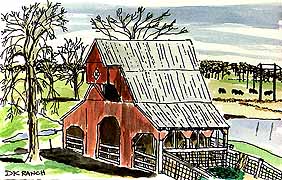
View in Piggott
Hemingway may have given us a wider perspective by rising up from
an absolute flatness of prose, but the insularity of Piggott refuses
to climb the ridge. At least that’s the report from Richard and
Carolyn. Of all the places we’ve stopped over on this journey,
Piggott sounds the most hidebound and hostile to outsiders. Our
friends transplanted here from Maine 3 years ago, following an
industrial career track. They grew up in western Virginia, so
their dialects have re-thickened, and they know the folkways.
But they have not been taken in as kin.
Carolyn teaches High School art in a nearby town, in overcrowded
classrooms with no materials, at a fraction of her Maine salary.
Maybe 20% of the kids climb the ladder out of their rural isolation.
She told us tales of guns in the classroom, and casual murders
in town. All that good delta blues.
In a previous incarnation, Richard was in middle management in
a Tennessee Nuclear operation, and had hair-raising stories to
tell about lack of security, hot materials going out the backdoor,
and other glowing reports. In the glory days before Three Mile
Island. But his prime complaint was the frozen classism of a southern
industrial shop. In the end he gave up trying to succeed by really
trying, in an institution that didn’t reward performance, and
booted his job security all the way to Freeport. Now he’s climbed
a ladder by merit, but it has left him straddling a ridge just
west of the floodplain.
Richard and Carolyn have poured all their creative energies into
building a post-modern cottage from plans in Southern Living Magazine.
A wide and deep veranda fronts the gable-ended manse, and soaring
cathedral spaces inside are full of winter light. They look forward
to sipping mint juleps looking over the horsy landscape. Meanwhile
every spare minute is spent running trim in the basement shop,
turning bannisters, building cabinets. The workmanship is beautiful,
in a house that is especially well thought-out. Graceful little
details and fundamental efficiencies meet a visitor at every turn.
But these two outsiders, their children grown and gone, seem to
rattle around in the bare spaces. Do we build grand houses to
enclose our isolations? I think of the Magdalen Islanders in their
tiny houses with their vast webs of extended kin and their outdoor
lives. Does an alienated affluence result in a country full of
big houses and no neighborhoods?
Our hosts were glad of the company and we had fun touring the
Christmas lightshow in Piggott. The local John Deere dealer has
the most elaborate display, and Richard tells us that there are
contractors who hire out to decorate houses and yards with seasonal
lights.. this yard, for example. As in Maine, some homeowners
go to extraordinary lengths to outshine the neighbors, but it
was the cul de sac behind a half-acre pond that easily took the
prize. All that holiday hoopla shining in the waters rivals the
country stars. We went home for juleps.
A meteor arcing down the sky met us when we arrived in Piggott,
but a dense overcast hung overhead as we came down onto the Mississippi
flats on Tuesday morning. A hard southwester was blowing loose
cotton across the roads as we looked away (Dixieland), and we
scudded before it across the southeast corner of Missouri. The
lowlying crossroad towns look soul-dead, and we realized that
Cairo, Illinois, where we were similarly depressed three months
ago, is only a few miles away. Some darkness of spirit flows down
into this drowned landscape, where Huck and Jim sought liberation.
The rectilinear roads do doglegs around the cotton fields and
winter fallows.
Then we cross the levee, and the roadbed lifts above flooded bottoms
and arches over the big river through green steel gridwork. The
waters are 7/10ths of a mile wide here, and nothing stirs on the
whitecapped expanse. Down the far side and we are back in the
East. Tennessee. And slouching toward Bethlehem.
The terrain begins to roll in long waves as we cut across the
northwest corner of Goreland, and there is milo in the fields
alongside the cotton. We are buffeted by tailwinds as we climb
into Kentucky, and the naked hardwoods in the hedgerows and copses
make dancing gestures against the gray. Unfamiliar habits and
barks, great tulip-shapes and scaly trunks. Clusters of trees
uniting in flat-topped fans for the rare crow to perch in. There
are fewer hawks. The great raptors who lined our way across Oklahoma
and Arkansas have given up this plowed country for the winter
grasslands. We saw a dead armadillo on the shoulder in western
Arkansas, but here the roadkill is all possums and coons.
And dams. We’ll have to come back to nose around TVA turf, but
we catch a sideview of one biggie where the Cumberland and the
Tennessee converge, then the topology lumps up. K-E-N-T-U-C-K-Y
spells relief. It’s like a homecoming to get in among real hills
again. As the parkways begin to bend and bobble we find ourselves
smiling, and we point at the sinewaving horizon. It could be Maine,
but for the lack of conifers. At first, only along the roads do
we see dark cedars bushing out, as though seeded by passing traffic.
The far peaks are whiskered with bare-limbed hardwoods against
a sullen saffron glow, and the gullies are gray with naked woods.
The land shows its bones in the roadcuts, stratified sedimentaries
looking like laid walls, landscaped with clinging cedars in the
niches. Then there are fields coming up in cedar, like runaway
Christmas tree farms, and then corn stalks, and we are in the
Midwest again.
We pull off the parkway (these are 50’s highways we are navigating:
with green median strips and old-style cloverleafs, where exiting
and entering autos must cross each other beneath underpasses)
to find a place to walk among unfamiliar species, and are amused
to find a man mowing the still verdant lawns of a graveyard in
mid-December. The air temp is in the 60’s, and even the nosy wind
isn’t unpleasant. Then we have a roadside meal that makes us declare
an end to eating roadfood this trip. We are roadweary, carsick,
highway hadit, NO MORE.
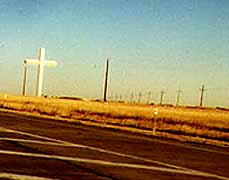
Road Cross
We had set off just after dawn, and it was sunset when we gave
it up in Frankfort, Kentucky. The solstice is approaching, and
there are storm warnings from California. One more stop and we
will dust-it for Bowdoinham. Will the skybeings smile on us one
last time?